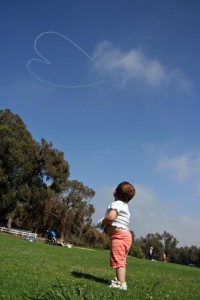
If you have ever been to a beach or sporting event, you might have seen a banner or billboard pulled behind a plane, advertising something. These signs tell of products or services, announce a special event, tell where to find further information (like a webpage), display political ads, and are used many other ways.
Probably these banner or billboard ads you saw were pulled behind a small single engine prop plane. Such a plane has sufficient power to pull the extra weight as well as the drag of the banner. But some companies offer banner ads that are pulled behind helicopters. This idea has pros and cons over the standard airplane.
First, helicopters are of course, much more versatile than planes. This makes them much more difficult to fly than airplanes. Therefore, special pilot training is required and this means greater expense. This maneuverability of the helicopter also demands much more from the engine. This means higher fuel costs and, again, more expense to the renter.
Normally when banner ads are pulled behind an airplane, the audience has an average of 17 seconds to read the message. Helicopters can fly more slowly and even hover to provide a longer viewing time. However, when pulling a banner, the speed must be great enough to keep the banner flowing and readable. If the billboard is hung below the plane instead of dragged behind, maximum viewing time is provided.
Conventional banner and billboard ad pulling involves attaching a rigid pole or support to the front of the banner so that it stays perpendicular to the ground. With weights attached to the bottom of the banner, it remains readable throughout the flying time.
The other method developed by skydivers is called Sling Load banner pulling. Here the helicopter basically pulls the upper corner of the banner and a weight is attached to the bottom of the leading edge so that it stays vertical. In spite of this weight, however, the ad often distorts as the wind hits it for the lower edge can’t keep up with the top. The weight could be as much as 500 pounds so a safety factor is also involved. Standard banners only require 10-15 pounds of weight to keep them vertical.
The advantage of the helicopter in pulling the banners is in the power of the plane. Because helicopters pull upward, and because their engines are much larger, they are able to pull much larger banners. Instead of the standard 3000 square feet sign, some have pulled banners as large as 50,000 square feet! Single engine planes would not be able to do this.
Both an airplane and a helicopter make enough noise to attract the attention of the spectators. Both methods provide the advantage of having a message presented to a large audience without competition in a very short period of time. And because of the unique presentation, it is almost guaranteed that the people will read it when it is flown overhead.
Once you have followed these principles, it is time to get in touch with an experienced company that provides aerial advertising services and get it printed and into the air. It won’t take long before your well-planned message will be read by thousands and the result in sales will follow.

